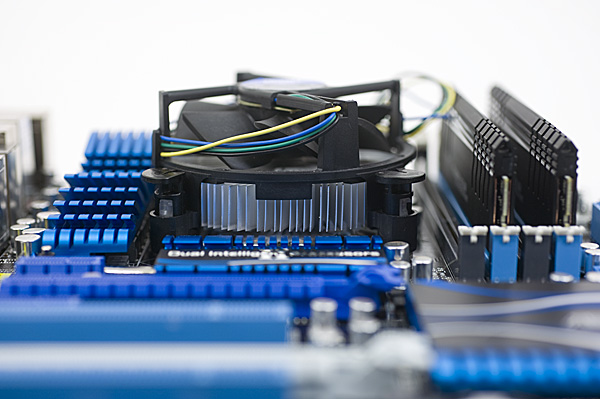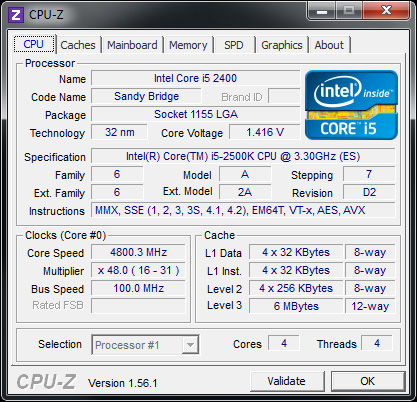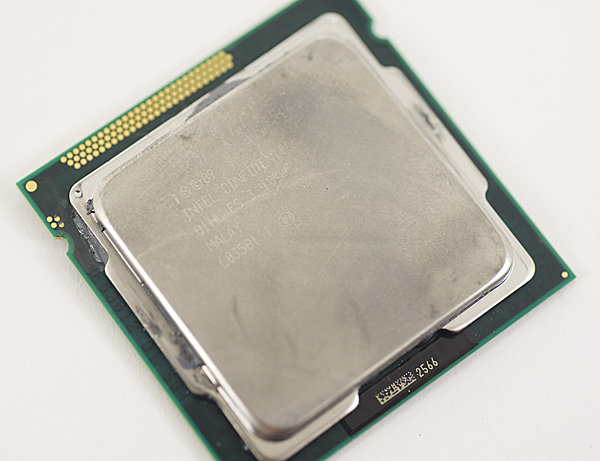The Sandy Bridge Review: Intel Core i7-2600K, i5-2500K and Core i3-2100 Tested
by Anand Lal Shimpi on January 3, 2011 12:01 AM ESTOverclocking, the K-Series and What You’ll Want to Buy
If you haven’t noticed, the computing world is becoming more integrated. We review highly integrated SoCs in our smartphone coverage, and even on the desktop we’re seeing movement towards beefy SoCs. AMD pioneered the integrated memory controller on desktop PCs, Intel followed suit and with Lynnfield brought a PCIe controller on-die as well. Sandy Bridge takes the next logical step and brings a GPU on-die, a move matched by AMD with Brazos and Llano this year.
In the spirit of integration, Intel made one more change this round: the 6-series chipsets integrate the clock generator. What once was a component on the motherboard, the PLL is now on the 6-series chipset die. The integrated PLL feeds a source clock to everything from the SATA and PCIe controllers to the SNB CPU itself. With many components driven off of this one clock, Intel has locked it down pretty tight.
With Nehalem and Westmere, to overclock you simply adjusted the BCLK from 133MHz to whatever speed you wanted and sometimes toyed with multipliers to arrive at a happy end result. With Sandy Bridge, the BCLK generated on the 6-series PCH is at 100MHz by default and honestly won’t go much higher than that.
While I’ve heard reports of getting as high as 115MHz, I’d view 103—105MHz as the upper limit for what you’re going to get out of BCLK overclocking. In other words: next to nothing. A 105MHz BCLK overclock on a Core i7-2600 will take you from a stock speed of 3.4GHz to a whopping 3.57GHz. The form of overclocking we’ve been using for the past decade is effectively dead on Sandy Bridge.
Years ago, before the Pentium II, we didn’t rely on BCLK (or back then it was just FSB or bus overclocking) to overclock. Back then, if we wanted a faster CPU we’d just increase the clock multiplier. Intel has dabbled in offering multiplier unlocked parts for overclockers, we saw this last year with the Core i7 875K for example. With Sandy Bridge, those unlocked parts are going to be a lot more important to overclockers.
It works like this. If you have a part that does not support Turbo (e.g. Core i3-2100 series), then your CPU is completely clock locked. You can’t overclock it at all, have fun at your stock frequency. This is good news for AMD as it makes AMD even more attractive at those price points.
If you have a part that does support turbo (e.g. Core i5-2400), then you have what’s called a “limited unlocked” core—in other words you can overclock a little bit. These parts are limited to an overclock of 4 processor bins above and beyond the highest turbo frequency. Confused yet? This chart may help:
In this case we’re looking at a Core i5-2500, which runs at 3.3GHz by default. When a single core is active, the chip can turbo up to 3.7GHz. If you want, you can change that turbo state to go as high as 4.1GHz (if your CPU and cooling can keep up).
Overclocking these limited unlocked chips relies entirely on turbo however. In the case above, the fastest your chip will run is 4.1GHz but with only one core active. If you have four cores active the fastest your chip can run is 3.8GHz. While Intel didn’t sample any limited unlocked parts, from what I’ve heard you shouldn’t have any problems hitting these multiplier limits.
There’s a third class of part: a fully unlocked K-series chip. At launch there are only two of these processors: the Core i5-2500K and the Core i7-2600K. Anything with a K at the end of it means you get all multipliers from 16x all the way up to 57x at your disposal. It’s effectively fully unlocked.

These chips overclock very well. Both my Core i5-2500K and Core i7-2600K hit ~4.4GHz, fully stable, using the stock low-profile cooler.

This is all you need for 4.4GHz
With a bit more effort and a better cooler, you can get anywhere in the 4.6-5.0GHz range:

It's a bit too early to tell how solid these near-5GHz overclocks will be, but I'm confident in the sub-4.5GHz overclocks we were able to sustain.
You do pay a price premium for these K-series SKUs. The 2500K will cost you another $11 over a stock 2500 and the 2600K costs an extra $23. In the case of the 2500K, that’s a small enough premium that it’s honestly worth it. You pay $11 extra for a chip that is very conservatively clocked and just begging for you to overclock it. Even the 2600K’s premium isn’t bad at all.
| Model Number | Standard SKU | K-Series SKU | Price Premium |
| Intel Core i7-2600 | $294 | $317 | +$23 |
| Intel Core i5-2500 | $205 | $216 | +$11 |
As an added bonus, both K-series SKUs get Intel’s HD Graphics 3000, while the non-K series SKUs are left with the lower HD Graphics 2000 GPU.
Compared to Lynnfield, you’re paying $11 more than a Core i5-760 and you’re getting around 10-45% more performance, even before you overclock. In a perfect world I’d want all chips to ship unlocked; in a less perfect world I’d want there to be no price premium for the K-series SKUs, but at the end of the day what Intel is asking for here isn’t absurd. On the bright side, it does vastly simplify Intel’s product stack when recommending to enthusiasts: just buy anything with a K at the end of it.
Since we’re relying on multiplier adjustment alone for overclocking, your motherboard and memory actually matter less for overclocking with Sandy Bridge than they did with P55. On both P67 and H67, memory ratios are fully unlocked so you can independently set memory speed and CPU speed. Even the GPU ratios are fully unlocked on all platforms and fully independent from everything else.












283 Comments
View All Comments
DanNeely - Monday, January 3, 2011 - link
The increased power efficiency might allow Apple to squeeze a GPU onto their smaller laptop boards without loosing runtime due to the smaller battery.yuhong - Monday, January 3, 2011 - link
"Unlike P55, you can set your SATA controller to compatible/legacy IDE mode. This is something you could do on X58 but not on P55. It’s useful for running HDDERASE to secure erase your SSD for example"Or running old OSes.
DominionSeraph - Monday, January 3, 2011 - link
"taking the original Casino Royale Blu-ray, stripping it of its DRM"Whoa, that's illegal.
RussianSensation - Monday, January 3, 2011 - link
It would have been nice to include 1st generation Core i7 processors such as 860/870/920-975 in Starcraft 2 bench as it seems to be very CPU intensive.Also, perhaps a section with overclocking which shows us how far 2500k/2600k can go on air cooling with safe voltage limits (say 1.35V) would have been much appreciated.
Hrel - Monday, January 3, 2011 - link
Sounds like this is SO high end it should be the server market. I mean, why make yet ANOTHER socket for servers that use basically the same CPU's? Everything's converging and I'd just really like to see server mobo's converge into "High End Desktop" mobo's. I mean seriously, my E8400 OC'd with a GTX460 is more power than I need. A quad would help with the video editing I do in HD but it works fine now, and with GPU accelerated rendering the rendering times are totally reasonable. I just can't imagine anyone NEEDING a home computer more powerful than the LGS-1155 socket can provide. Hell, 80-90% of people are probably fine with the power Sandy Bridge gives in laptops now.mtoma - Monday, January 3, 2011 - link
Perhaps it is like you say, however it's always good for buyers to decide if they want server-like features in a PC. I don't like manufacturers to dictate to me only one way to do it (like Intel does now with the odd combination of HD3000 graphics - Intel H67 chipset). Let us not forget that for a long time, all we had were 4 slots for RAM and 4-6 SATA connections (like you probably have). Intel X58 changed all that: suddenly we had the option of having 6 slots for RAM, 6-8 SATA connections and enough PCI-Express lanes.I only hope that LGA 2011 brings back those features, because like you said: it's not only the performance we need, but also the features.
And, remeber that the software doesn't stay still, it usualy requires multiple processor cores (video transcoding, antivirus scanning, HDD defragmenting, modern OS, and so on...).
All this aside, the main issue remains: Intel pus be persuaded to stop luting user's money and implement only one socket at a time. I usually support Intel, but in this regard, AMD deserves congratulations!
DanNeely - Monday, January 3, 2011 - link
LGA 2011 is a high end desktop/server convergence socket. Intel started doing this in 2008, with all but the highest end server parts sharing LGA1366 with top end desktop systems. The exception was quad/octo socket CPUs, and those using enormous amounts of ram using LGA 1567.The main reason why LGA 1155 isn't suitable for really high end machines is that it doesn't have the memory bandwidth to feed hex and octo core CPUs. It's also limited to 16 PCIe 2.0 lanes on the CPU vs 36 PCIe 3.0 lanes on LGA2011. For most consumer systems that won't matter, but 3/4 GPU card systems will start loosing a bit of performance when running in a 4x slot (only a few percent, but people who spend $1000-2000 on GPUs want every last frame they can get), high end servers with multiple 10GB ethernet cards and PCIe SSD devices also begin running into bottlenecks.
Not spending an extra dollar or five per system for the QPI connections only used in multi-socket systems in 1155 also adds up to major savings across the hundreds of millions of systems Intel is planning to sell.
Hrel - Monday, January 3, 2011 - link
I'm confused by the upset over playing video at 23.967hz. "It makes movies look like, well, movies instead of tv shows"? What? Wouldn't recording at a lower frame rate just mean there's missed detail especially in fast action scenes? Isn't that why HD runs at 60fps instead of 30fps? Isn't more FPS good as long as it's played back at the appropriate speed? IE whatever it's filmed at? I don't understand the complaint.On a related note hollywood and the world need to just agree that everything gets recorded and played back at 60fps at 1920x1080. No variation AT ALL! That way everything would just work. Or better yet 120FPS and with the ability to turn 3D on and off as u see fit. Whatever FPS is best. I've always been told higher is better.
chokran - Monday, January 3, 2011 - link
You are right about having more detail when filming with higher FPS, but this isn't about it being good or bad, it's more a matter of tradition and visual style.The look movies have these days, the one we got accustomed to, is mainly achieved by filming it in 24p or 23.967 to be precise. The look you get when filming with higher FPS just doesn't look like cinema anymore but tv. At least to me. A good article on this:
http://www.videopia.org/index.php/read/shorts-main...
The problem with movies looking like TV can be tested at home if you got a TV that has some kind of Motion Interpolation, eg. MotionFlow called by Sony or Intelligent Frame Creation by Panasonic. When turned on, you can see the soap opera effect by adding frames. There are people that don't see it and some that do and like it, but I have to turn it of since it doesn't look "natural" to me.
CyberAngel - Thursday, January 6, 2011 - link
http://en.wikipedia.org/wiki/Showscan